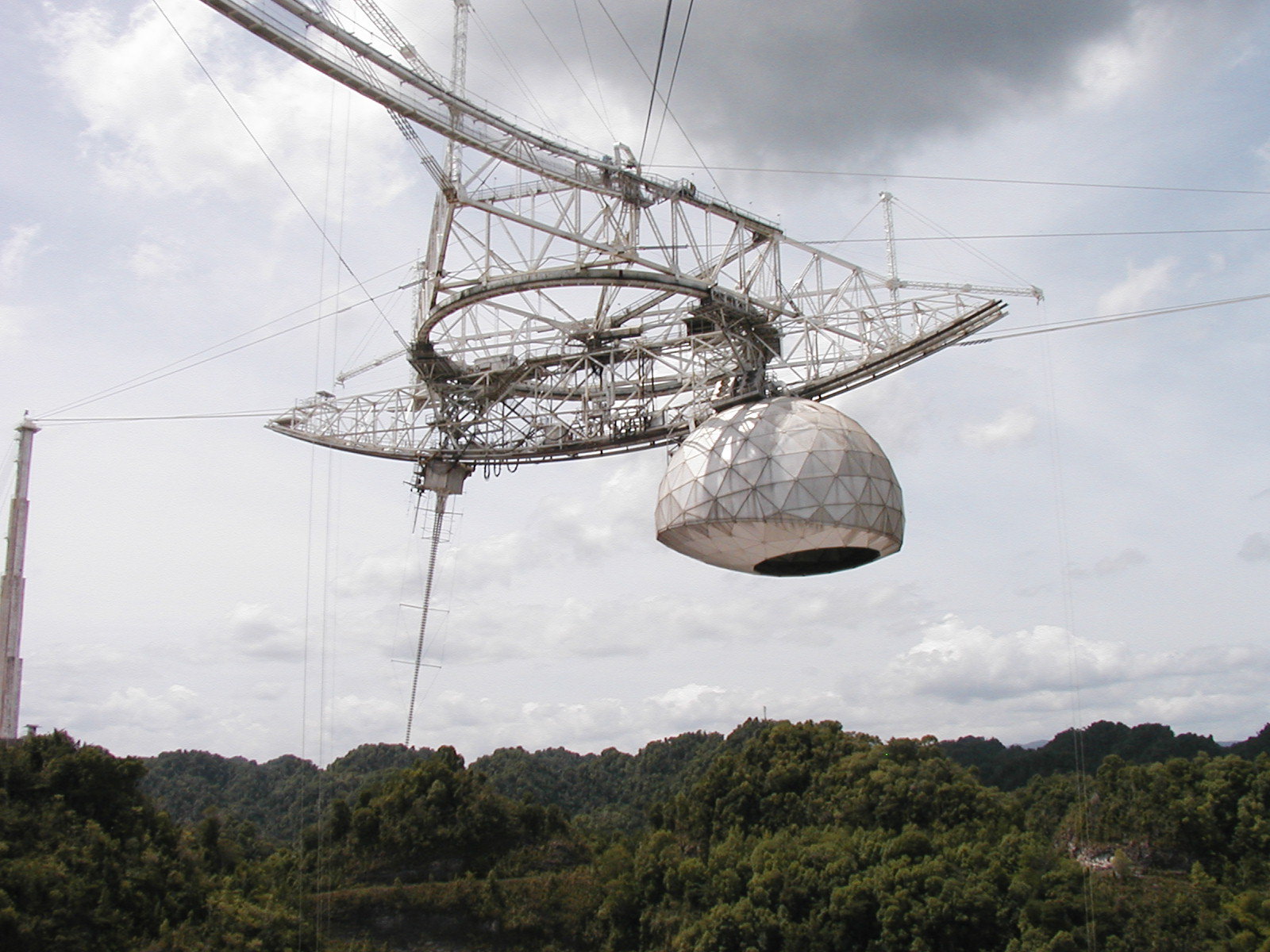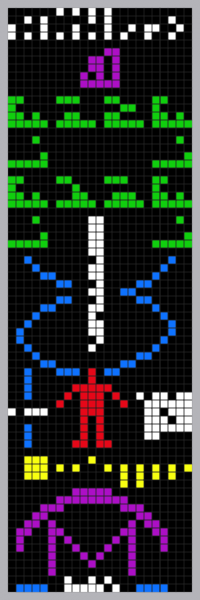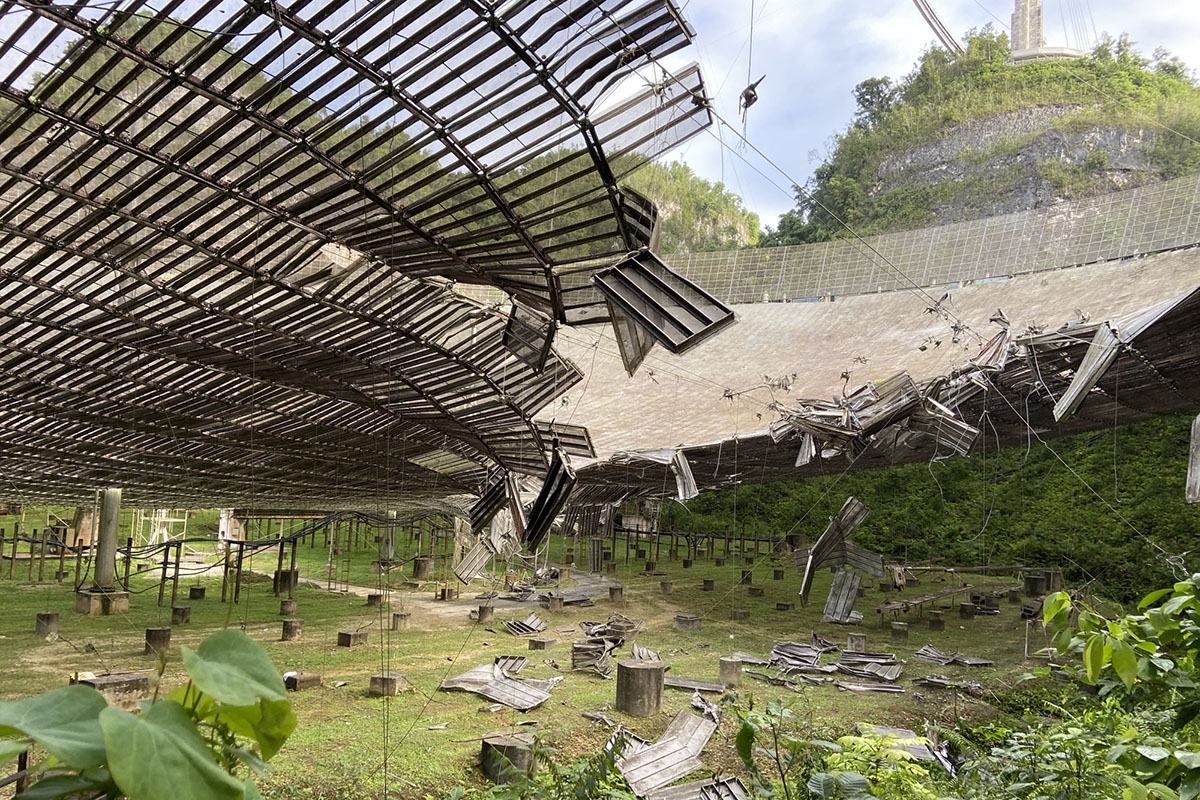The Arecibo Observatory is an iconic institution. Located in Puerto Rico, this National Science Foundation (NSF) observatory was the largest radio telescope in the world between 1963 and 2016. While that honor now goes to the Five hundred meter Aperture Spherical Telescope (FAST) in China, Arecibo will forever be recognized for its contributions to everything from radio astronomy to the Search for Extraterrestrial Intelligence (SETI).
Unfortunately, the Arecibo Observatory suffered serious damage when on Monday, Aug. 10th, an auxiliary cable that supports the platform suspended above the telescope reflector dish broke. The cable struck the Gregorian Dome (which sits on the underside of the platform) before landing on the reflector dish, which created a gash over 30 meters (100 feet) in length and forced the observatory to temporarily shut down operations.
While it remains unclear why the cable broke, information about the timing and resulting damage has been released. According to a statement by the National Astronomy and Ionosphere Center (NAIC), the incident occurred at 02:45 a.m. local time (11:45 p.m. PDT) when a 7.62 cm (3-inch) cable broke and fell. The cable struck 6 to 8 panels in the Gregorian Dome and twisted the access platform before landing on the reflecting dish.

This dome is where the Arecibo L-band Feed Array (ALFA) multi-beam receiver is located, a seven feed system that allows for large-scale radio surveys of the sky to be conducted. In response to the incident, operations at the observatory have ceased and the science and visitor center have been closed until a team of engineers can assess the cause of broken cable and effect repairs.
Said Francisco Cordova, the director of the observatory, in a recent NAIC press statement:
“We have a team of experts assessing the situation. Our focus is assuring the safety of our staff, protecting the facilities and equipment, and restoring the facility to full operations as soon as possible, so it can continue to assist scientists around the world.”
Not only is Puerto Rico located in the “hurricane belt,” but it also sits atop a tectonically active region. As a result, the Arecibo Observatory has endured many hurricanes, tropical storms, and earthquakes during its over fifty-year history. Hurricane Maria, which caused extensive damage to the island in 2017, also damaged the observatory – the repairs of which are still incomplete.

Nevertheless, the facility has remained operational throughout and has continued to contribute to significant breakthroughs in astronomy and cosmology. This includes confirming the existence of neutron stars, the discovery of the first binary pulsar, the first-millisecond pulsar, the first exoplanets, and the characterization of asteroids and planets in the Solar System.
In addition, the facility has also played an important role in the Search for Extraterrestrial Intelligence (SETI) and even Messaging Extraterrestrial Intelligence (METI) – aka. “Active SETI”. In addition to providing the source data for SETI@home ad the SETI Institute’s Project Pheonix, Arecibo is also one of the few installations in the world to actively send an encoded message to space intended for extraterrestrials.

This was known as the Arecibo Message, a 1,679 bit binary pattern image that was broadcast in 1974 in the direction of the M13 globular cluster (located 21,000 light-years away). It included numbers, chemical formulae, and a visual representation of the human form and where the message was sent from. The message was crafted by famed scientists Frank Drake and Carl Sagan and remains the most powerful signal ever to be sent to space.
The University of Central Florida (UCF) manages the observatory under a cooperative agreement with Universidad Ana G. Méndez (UAGM) and Yang Enterprises, Inc. (YEI). At present, Arecibo is also home to the research group that runs the Planetary Radar Project, an initiative that tracks and characterizes near-Earth objects (NEOs). This project is supported by NASA’s Near-Earth Object Observations Program, which is part of the NASA Planetary Defense Coordination Office.
If there’s one thing that people can agree on in these highly-divisive times, it’s that the Arecibo Observatory deserves to make a speedy recovery. She’s an old observatory, but still a premiere one, and she’s got many years of life left in her yet!
Further Reading: NAIC

